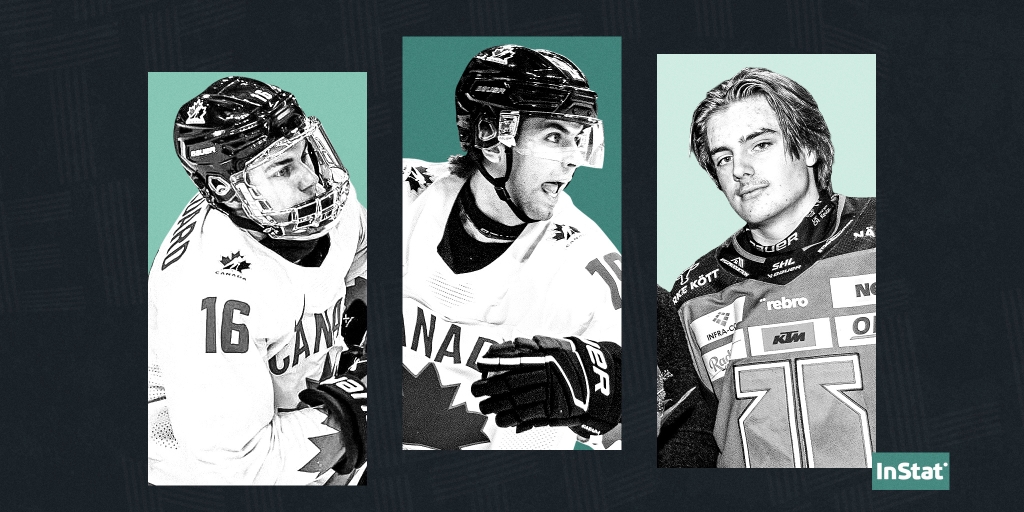The Elite Prospects January ranking of the top 64 prospects in the 2023 NHL Draft


If there was any doubt, the World Juniors cemented Connor Bedard’s status as not just the draft’s top prospect, but a truly generational talent.
But Bedard isn’t the only top-end prospect available. The draft’s littered with them, evidenced by the incredible production of many, as well as several impressive performances at the World Juniors.
Leo Carlsson’s strong showings for Sweden tempted our team to bump him to the No. 2 rank. After all, the gap between Adam Fantilli and him was small at our last meeting. Razor-thin. Any argument one way or the other could have triggered a flip, but we held off from making the move right now.
Carlsson is a more mature player. His already pro-style of game was always going to translate better to a best-on-best tournament like the World Juniors. He’s more versatile, makes better decisions with the puck, and doesn’t need it as much to influence the game.
Fantilli performs better when the attack is funnelled through him, like with the Michigan Wolverines. He thrives when he gets to maintain possession, traverse neutral zones, and orchestrate scoring chances in the offensive end.
Because of clear improvements in Fantilli’s choices of plays, overall playmaking ability, and anticipation of the game over the past year – and because he also plays in a great development program -- we are betting that his game will evolve as he learns what works for him and what doesn’t. A more mature Fantilli is one that could pull off many of the same plays as Carlsson but do so more dynamically. This debate is far from over, however.
Matvei Michkov easily slotted at the No. 4 spot. Dylan Griffing, Elite Prospects Russia regional scout, has reservations about his play style, notably his lack of defensive engagement and tendency to throw pucks away or to hold it too long, but no other remaining prospect is more likely to end up as a great NHL scorer down the line.
It’s hard for 18-year-olds to impose their will in KHL games, but Michkov does it in flashes. He deceives defenders and orchestrates complex passing plays, transforms pass receptions into dangles into shots, and rushes the puck from zone to zone. His overall pace of play and physicality are ramping up and easing some of our concerns about his NHL projection.
Michkov is not a lock at fourth overall, but if he is to move down, it will be because one – or more – of the next few players on the list steal it from him.
Those next few are currently caught up in another series of contested debates, leading to the first changes of the board. Zach Benson overtook Andrew Cristall, while Oliver Moore claimed Will Smith's No. 7 spot. Benson’s adaptable, high-pace game screams top-six NHLer, capable of filling a variety of roles – and the net in each of them. Moore’s dynamic skating and increased chance creation of late give him a slight edge over the electrifying Smith.
Ryan Leonard moves into the top-10 after landing in the No. 17 spot, thanks to ringing endorsements from EP scouts Joey Padmanabhan and Russ Cohen. Much like Jimmy Snuggerud, his game likely looks different in college, with the efficient style and flashes of play-driving skills becoming greater parts of his game.
Another major riser is No. 15-ranked David Reinbacher, omitted from last month’s top 32 entirely. His defensive game wasn’t in doubt, but he quickly answered questions about his puck game at the World Juniors. He created advantages in transition, beating multiple forecheckers at once, and showed a consistent activation game with flashes of creativity. It paints his league play in a positive light, showing that he has the skills to create in the NHL. A strong second half will lead to another bump up the rankings.
William Whitelaw, a toolsy, confident shooter rises from the No. 24 rank to 16 after his recent growth as a playmaker and distributor noted by lead scout David St-Louis and Padmanabhan. Quentin Musty moves up for similar reasons. Oscar Fisker Mølgaard’s skating, puck skills, intelligence, and sharp upward trajectory have the entire team excited about his long-term potential, earning him a spot in the top 32.
On the other side, there are the fallers. The two most notable are Dalibor Dvorský and Mikhail Gulyayev. Both players have NHL-calibre tools – Gulyayev’s skating could even grade as elite – but they need to show that they can use their tools to manipulate defenders and create plays, passes and shooting lanes, a little more often.
Across the pond, both Brayden Yager fell nine spots, while Calum Ritchie slipped seven. Both still project as NHL players, but their inability to consistently generate high-value offence at 5-on-5 generates some concern about their long-term upside. Luca Cagnoni slipped 11 spots, partly because of the impressive play of others in the range, and partly due to concerns about his game beyond his edges and activation.
There was no shortage of debate, either. Riley Heidt and Nate Danielson’s recent play have us wondering if their No. 18 and No. 25 spots are several spots too low. Gavin Brindley’s standout World Juniors showed off a bit more playmaking than he’s shown in college, yet he only rose one spot. Tanner Molendyk’s standout tools and Lukas Dragicevic’s production both have us wondering if we put them at the bottom end of their range.
The Elite Prospects scouting team convenes next in mid-March, at which point we'll rank 96 prospects for the 2023 NHL Draft.

